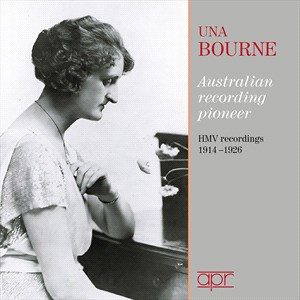“Una Mabel Who?” Don’t worry, that’s also how I responded to a fellow historic piano recording geek’s inquiry about Una Mabel Bourne (1882-1974). Actually her name vaguely rang a bell, but I had never heard any of this once-popular yet long-forgotten Australian pianist’s numerous recordings, and I knew nothing about her career.
She concertized internationally, frequently appearing with legendary soprano Nellie Melba as an “assisting artist”. From 1942 she largely focused her energies on teaching, establishing a school of piano playing at the Melbourne Conservatorium of Music. Apparently Bourne made no commercial recordings beyond the 91 titles she set down for the HMV label between 1914 and 1926. The majority consist of short, encore-type pieces, yet the repertoire often expands beyond the proverbial beaten track. Indeed, her 1921 Grieg Piano Sonata (with an abridged finale) was this work’s premiere recording. The interpretation is direct and forthright, if rather cut and dried, as are a selection of the composer’s Lyric Pieces, especially Bourne’s drag racing through Papillons.
Her Wagner Liszt Spinning Chorus and Liebestod and Verdi/Liszt Rigoletto Paraphrase readings are fast and facile, yet nothing more. Ditto her Mozart Rondo alla Turca. Yet by playing Tchaikovsky’s June from The Seasons twice as fast as anyone else, Bourne manages to liberate the music from decades’ worth of built-up schmaltz and schmutz. Her rhythmic vivacity and hard-hitting accents in Paderewski’s Cracovienne fantastique make this music sound more important than it is.
If her Weber Rondo Brilliante lacks the stylish elegance of Emma Boynet’s extraordinary recording reissued recently by APR, you’ll rarely hear Stephen Heller’s Tarantella in A-flat or Sydney Smith’s dazzlingly empty-headed Le jet d’eau served up with comparable flair.
For some reason, the music of Cecile Chaminade elicited Bourne’s most nuanced, thoughtful, and involved interpretations on disc. She patiently shapes the pearly runs in Fileuse, and judges the climaxes in Automne with the utmost care. And her slight accelerations in Pierrette impart a sardonic, angular edge to the piano writing’s surface charm. Clearly Chaminade had a fervent champion in Una Mabel Bourne, while short works by Cyril Scott and Selim Palmgren also benefit from this pianist’s characterful appeal.
Needless to say, Bourne brings requisite sparkle and authority to four of her own salon-like compositions. As usual, APR’s transfers are as good as we’re going to get, not to mention Jeremy Nicholas’ brilliantly researched and informative annotations.
































